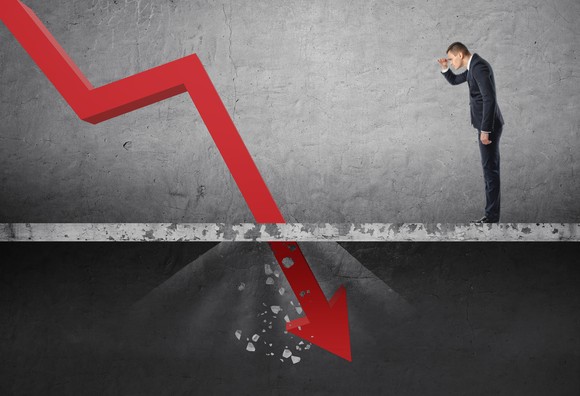Medical professionals usually buy their scrubs and uniforms from a fragmented network of aging medical apparel suppliers. However, those clothes have a reputation for being boxy, poorly fitted, and uncomfortable.
That's why Figs (FIGS +3.50%), which sells fashionable and fitted scrubs and medical uniforms through an online-only store, gained a lot of attention when it went public in May 2021. It listed its shares at $22, started trading at $28.30, and surged to an all-time high of $50.10 the following month. But today, Figs trades nearly 90% lower at about $6 a share. Let's see why its stock crashed -- and it's worth buying as a turnaround play.

Image source: Getty Images.
When a hypergrowth stock stops growing
In 2022, Figs' number of active customers rose 23% to 2.3 million, its average order value (AOV) grew 7% to $112, but its net revenue per active customer dipped 1% to $221. Its total revenue rose 21% to $506 million. But as the following table illustrates, Figs' growth decelerated significantly over the past three years.
|
Metric |
2020 |
2021 |
2022 |
|---|---|---|---|
|
Active customer growth |
118% |
46% |
23% |
|
AOV growth |
(1%) |
12% |
7% |
|
Net revenue per active customer growth |
10% |
11% |
(1%) |
|
Revenue growth |
138% |
59% |
21% |
Data source: Figs.
Figs expects that slowdown to continue with "mid-single-digit" revenue growth in 2023, while analysts anticipate just 6% growth. During the latest conference call, CFO Daniella Turenshine blamed that deceleration on "macro uncertainty and high inflation rates" and predicted its growth in active customers would "moderate" as it lapped its "strong growth" over the past few years. Turenshine also expects Figs' margins to be compressed by a "higher mix of promotional sales" as it focuses on reducing its inventory -- which jumped 73% in 2021 and 106% in 2022.
Furthermore, Figs co-CEO Trina Spear noted that the company's recent launches of new colors, which had reliably boosted its sales in the past, "did not perform to the elevated levels we saw last year." However, Spear said she was still "very pleased" with its recent introduction of extended (larger) sizes to reach a wider range of customers.

NYSE: FIGS
Key Data Points
Margins will continue to decline
As Figs' top-line growth cooled off, its margins according to gross and adjusted earnings before interest, taxes, depreciation, and amortization (EBITDA) were squeezed by a higher mix of lower-margin products and elevated freight costs. As a result, its adjusted EBITDA growth stalled out.
|
Metric |
2020 |
2021 |
2022 |
|---|---|---|---|
|
Gross margin |
72.3% |
71.8% |
70.1% |
|
Adjusted EBITDA margin |
26.3% |
25.1% |
17.2% |
|
Adjusted EBITDA growth |
3,965% |
52% |
(17%) |
Data source: Figs.
Figs expects that pressure to worsen and reduce its adjusted EBITDA margin to 11%-12% in 2023. Analysts expect its adjusted EBITDA to decline another 28% in 2023.
Figs' decelerating revenue growth and declining margins dispel the notion that it could become the "next Lululemon" -- as many bulls proclaimed -- anytime soon. Lululemon, which carved out a high-growth niche in the yoga and activewear market, is expected to grow both its revenue and adjusted EBITDA by 28% this fiscal year.
On the bright side, FIGS is profitable on the basis of generally accepted accounting principles (GAAP), and it still held $160 million in cash and equivalents at the end of 2022. Its low debt-to-equity ratio of 0.3 also gives it plenty of room to raise fresh cash.
Could Figs be a deep-value play?
With an enterprise value of $764 million, Figs trades at just 1.4 times this year's sales and 12 times its adjusted EBITDA. By comparison, Lululemon trades at 4.6 times this year's sales and 18 times its adjusted EBITDA.
Therefore, Figs' stock looks cheap -- but it could still get a lot cheaper unless it stabilizes its revenue, inventory levels, and margins. Until all of those things happen, I can't recommend buying Figs as a value play yet.